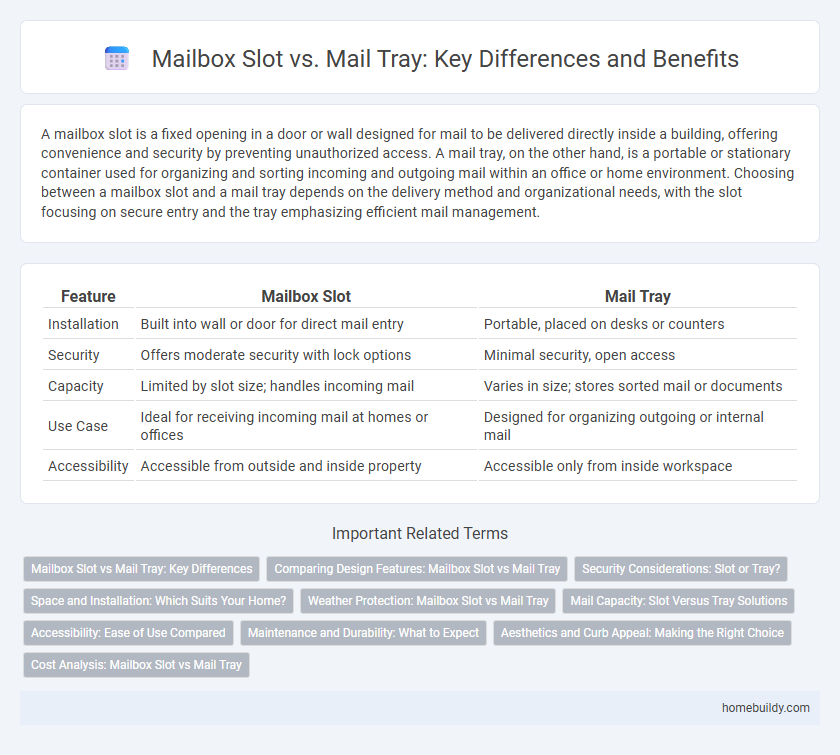A mailbox slot is a fixed opening in a door or wall designed for mail to be delivered directly inside a building, offering convenience and security by preventing unauthorized access. A mail tray, on the other hand, is a portable or stationary container used for organizing and sorting incoming and outgoing mail within an office or home environment. Choosing between a mailbox slot and a mail tray depends on the delivery method and organizational needs, with the slot focusing on secure entry and the tray emphasizing efficient mail management.
Table of Comparison
| Feature | Mailbox Slot | Mail Tray |
|---|---|---|
| Installation | Built into wall or door for direct mail entry | Portable, placed on desks or counters |
| Security | Offers moderate security with lock options | Minimal security, open access |
| Capacity | Limited by slot size; handles incoming mail | Varies in size; stores sorted mail or documents |
| Use Case | Ideal for receiving incoming mail at homes or offices | Designed for organizing outgoing or internal mail |
| Accessibility | Accessible from outside and inside property | Accessible only from inside workspace |
Mailbox Slot vs Mail Tray: Key Differences
Mailbox slots are built-in openings on doors or walls designed for secure mail delivery directly into a designated space within a building, whereas mail trays are external containers used for organizing and holding mail after it has been received. The key differences lie in functionality and placement; mailbox slots facilitate seamless drop-off of mail without needing external handling, while mail trays serve as sorting tools typically placed inside offices or homes. Mailbox slots often offer enhanced security and weather protection, unlike mail trays, which require manual collection and are more exposed to environmental factors.
Comparing Design Features: Mailbox Slot vs Mail Tray
Mailbox slots are typically integrated into doors or walls, featuring a secure, narrow opening designed to allow mail to drop directly inside, enhancing security and weather protection. Mail trays, on the other hand, are external or desktop organizers with open compartments that facilitate easy sorting and retrieval but offer less protection from theft or environmental damage. The design of mailbox slots prioritizes security and space efficiency, while mail trays emphasize accessibility and organization.
Security Considerations: Slot or Tray?
Mailbox slots offer enhanced security by restricting access to incoming mail, reducing the risk of theft or tampering compared to mail trays. Mail trays, often used indoors, provide less protection as mail is more exposed and accessible to unauthorized individuals. For sensitive documents, mailbox slots with sealed compartments ensure better confidentiality and protection.
Space and Installation: Which Suits Your Home?
Mailbox slots save space by integrating directly into doors or walls, making them ideal for homes with limited exterior room. Mail trays require additional surface area, often mounted inside entryways or foyers, which may not suit smaller or minimalist homes. Installation of mailbox slots is typically more secure and weather-resistant, whereas mail trays offer easier access but demand more indoor space.
Weather Protection: Mailbox Slot vs Mail Tray
Mailbox slots offer superior weather protection by securely enclosing mail within the building or door, preventing exposure to rain, snow, and wind. In contrast, mail trays, typically placed outdoors or in open areas, leave mail vulnerable to weather damage and require more frequent monitoring. Choosing a mailbox slot reduces the risk of water damage and ensures that important documents remain dry and intact.
Mail Capacity: Slot Versus Tray Solutions
Mailbox slots offer limited mail capacity, typically accommodating letters and small envelopes, making them ideal for minimal daily mail influx. Mail trays provide larger capacity, allowing for the organization and storage of bulkier items such as magazines, catalogs, and multiple parcels. Choosing between a slot and a tray depends on the volume and types of mail to be received regularly.
Accessibility: Ease of Use Compared
Mailbox slots offer direct access through a wall or door, allowing users to easily deposit mail without opening a separate container, enhancing convenience in high-traffic areas. Mail trays require opening or reaching into a compartment, which can be less accessible, especially for individuals with limited mobility. The simplicity of mailbox slots provides superior ease of use and quicker retrieval compared to the often bulkier and more enclosed mail trays.
Maintenance and Durability: What to Expect
Mailbox slots require minimal maintenance due to their simple design and durable materials like stainless steel or aluminum, offering long-lasting performance even in harsh weather. Mail trays, constructed often from plastic or lightweight metal, demand more frequent cleaning and repairs to prevent wear and damage from moisture and UV exposure. Choosing mailbox slots ensures enhanced longevity and lower upkeep costs compared to mail trays.
Aesthetics and Curb Appeal: Making the Right Choice
Mailbox slots offer a sleek, integrated look that enhances a home's facade by maintaining clean lines and minimal visual clutter, boosting curb appeal. Contrastingly, mail trays are more utilitarian and can disrupt exterior aesthetics if not carefully coordinated with the overall design. Choosing between a mailbox slot and a mail tray depends heavily on the desired exterior style and how seamlessly the mail solution blends with the architectural elements.
Cost Analysis: Mailbox Slot vs Mail Tray
Mailbox slots generally offer a more cost-effective solution compared to mail trays, as they require minimal installation and maintenance expenses. Mail trays often involve higher upfront costs due to materials and assembly, and additional space requirements can increase long-term facility costs. Evaluating total cost of ownership shows mailbox slots provide budget-friendly efficiency for managing incoming mail.
Mailbox slot vs Mail tray Infographic

 homebuildy.com
homebuildy.com